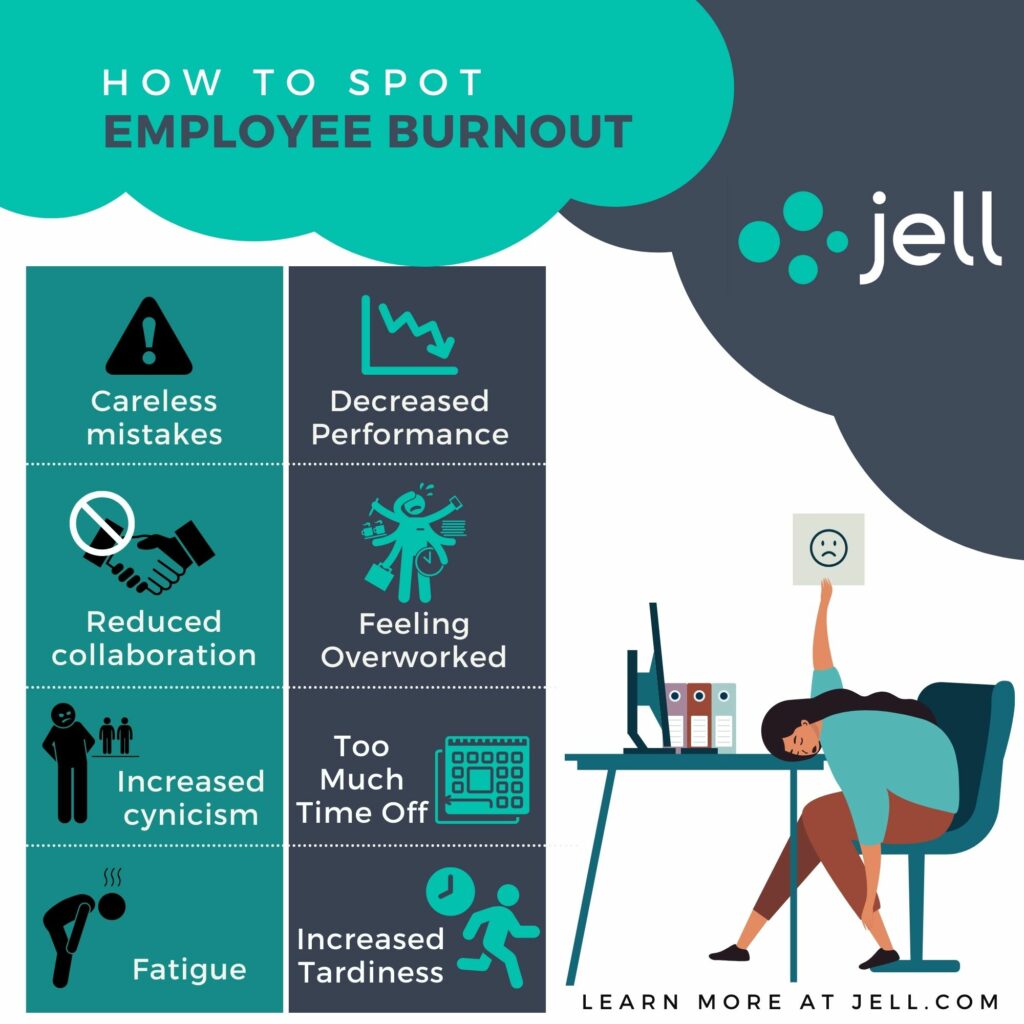It’s important to look for employee burnout signs. When employees get overstressed, all kinds of bad things can happen. They are more prone to make mistakes, become actively disengaged, and even face increased risks of serious health problems ranging from high blood pressure to depression.We know from the American Institute of Stress that 80% of U.S. employees feel stress on the job. And, one in four says they’re “often or very often” burned out by work. This problem can be especially acute for engineering teams, where the demands are high, and the hours can get long.As a manager, it’s your job to recognize and address the symptoms of employee burnout quickly. But you can’t take steps to counter burnout until you recognize it.
 Below are five telltale signs of employee burnout.While the presence of one solitary symptom isn’t necessarily a strong indicator—there’s usually another explanation for the presence of any one of these in isolation—I’d sit up and pay attention when more than one begins to surface.
Below are five telltale signs of employee burnout.While the presence of one solitary symptom isn’t necessarily a strong indicator—there’s usually another explanation for the presence of any one of these in isolation—I’d sit up and pay attention when more than one begins to surface.




Give your Employees the Tools to Succeed
Write OKRs, share progress, monitor success.
14-day free trial. No credit card required.
What are the consequences of employee burnout?
It’s important to address and solve burnout as quickly as possible. Unaddressed burnout can have significant health consequences and impediments to a healthy lifestyle including:Health consequences:- Chronic stress
- Fatigue
- Insomnia
- Irritability
- Depression
- Substance abuse
- Heart disease
- Obesity
- High blood pressure
- Type 2 diabetes
- Susceptibility to illnesses
- Withdrawing from friends and colleagues
- Inability to perform job
- Drain on company resources
- Job dissatisfaction
What causes employee burnout?
Lack of Autonomy
Some employees may feel as though they lack autonomy in their job. Perhaps they don’t have access to the right resources or say in professional decisions–this can degrade their sense of purpose in the workplace. Afterall, if they aren’t trusted to do their job then why should they try?This is also the perfect opportunity for you, as the manager, to ask yourself about your managerial habits. Do you contact your employees at all hours of the day and night, even when they’re not working? Are you constantly pulling the rug from under your employees by shifting priorities? Are you giving them the correct resources for doing their job? How can you establish better boundaries with your team? How can you provide better resources to your employees? Consider these questions and see if there is anything you can change in your treatment of your team.Workload
Having the perfect balance between workload and an individual’s capacity for work grants opportunities for rest and relaxation, and time for professional growth and development. When an employee feels chronically overloaded, they’re overwhelmed and are left with little opportunity to recharge and restore their balance outside of their job. They come into your workplace with little energy to put into their role.Community
Does your workplace have a sense of community? Do your employees feel like they are a part of a team? You can improve the dynamics of your team to improve the sense of community. Encourage communication among employees. Start a Slack channel conversation asking them how their day is going or about something they’ve learned during the week. Send private messages to your employees naming one thing you appreciate about them. Unfortunately, sometimes burnout is contagious, which is why it’s important to elevate your employees’ engagement. Shift the morale of the group.Reward
Your employees don’t feel as though extrinsic and intrinsic rewards don’t match the effort they put into their job. They aren’t feeling appreciated for the time and work they put in, so of course they’re starting to feel burned out. They’ll eventually feel like the investment in your company isn’t worth the payoff.Are there opportunities to appreciate your employees more? Are there any employees who are late for a raise or promotion? Have you been only doling out negative feedback that you’ve forgotten to give positive feedback.[/et_pb_text][et_pb_text _builder_version=”4.16″ background_size=”initial” background_position=”top_left” background_repeat=”repeat” global_colors_info=”{}”]Fairness
Employees start to feel burnout when they don’t feel their workplace is fair. Some employees get acknowledgements and praise, and others simply don’t. Maybe some get deadline extensions or access to additional resources, and others don’t. A mismatch in effort and acknowledgment can build resentments among your employees.Value misalignment
Sometimes an employee’s values don’t align with the values of the company. Ideals and motivations are deeply ingrained in the identity of individuals and organizations. And also…Sometimes values shift. An employee may have valued something they no longer value now, or perhaps your company’s values have shifted.Burnout isn’t just being tired. It’s a complex issue requiring a multifaceted solution. Which brings us to an important question…What are the signs of employee burnout?
 Below are five telltale signs of employee burnout.While the presence of one solitary symptom isn’t necessarily a strong indicator—there’s usually another explanation for the presence of any one of these in isolation—I’d sit up and pay attention when more than one begins to surface.
Below are five telltale signs of employee burnout.While the presence of one solitary symptom isn’t necessarily a strong indicator—there’s usually another explanation for the presence of any one of these in isolation—I’d sit up and pay attention when more than one begins to surface.1. You’re Seeing More Bugs in Production
An unusual increase in errors could be a sign that your employee is taking on more complex and challenging work.But if it’s consistently accompanied by lower-than-expected quality of work in other areas, more bugs might mean disengagement is causing your team member to avoid putting in the extra effort to check the quality of their work.
2. Your Roadmap Derails to Chase Shiny Objects
When engineers experience employee burnout, they’ll sometimes attempt to gain a renewed sense of motivation by introducing new technology. Don’t get me wrong: Welcoming ideas and innovation is a good move for any tech company.But if those re-architecture attempts are taking up time that could otherwise be spent pursuing overarching business objectives and key results, they may not be driven by a real need.When a product roadmap is derailed to pursue a new programming language or infrastructure, particularly if there are no clear performance or cost-savings goals, it could be a sign that your team member isn’t into existing projects and needs help regaining a sense of purpose at work.
3. You Stopped Shipping Early and Often
Every engineer has unique habits around how often they commit code and submit pull requests. It’s not unheard of for these patterns to change, especially when a seasoned employee starts taking on more complex projects. (Because let’s face it: Measuring lines of code written is a terrible way to measure productivity). However, if those commits really start to dwindle over time, it could be a sign that your employee is distracted and withdrawing from the work.
4. You’re Seeing Reduced Engagement and Collaboration
This one’s a strong sign of employee burnout, though it can sometimes be more difficult to recognize. If someone seems to care less and less about what’s happening with the team overall, it’s very often due to disengagement.How do you spot this symptom? It might be that a team member isn’t commenting on pull requests as much as she used to. Or he’s not speaking up in sprint planning and retrospective meetings. Once you’ve worked with someone long enough to know their work habits, these are the nuanced changes to watch for.
5. You’re Seeing Increased Cynicism and Unconstructive Criticism
Have you ever dealt with an employee who likes to rip apart team members in pull requests for things like stylistic errors or subjective points? It’s not the fun side of management. If it’s been a pattern of behavior from day one, you probably made a bad hire. But if your otherwise collaborative team member suddenly starts trashing architecture decisions, product roadmaps, and coworkers’ skills, it’s a sure sign of burnout.
6. You’re Seeing Alienation from Other Employees
When employees are feeling burned out, they tend to withdraw from others in all aspects of their lives. If you notice that an employee was once active in the Slack channel but isn’t anymore, you may have a burned-out employee on your hands.7. You’re Seeing Fatigue on the Job
Your employees are coming to work disheveled and look tired. If they’re complaining about feeling exhausted all the time, they may be experiencing burnout. When employees are overloaded with stress at work it can be near impossible for them to relax at the end of the day or sleep well. They’re constantly in a cycle of fatigue.When an employee is sleep deprived, they can experience more than simple sleepiness. Effects can range from hallucinations, trouble recalling memories, and even physical pain. In the long term, chronic fatigue can lead to obesity and heart disease.8. You’re Seeing Increased Time Off
We are proponents of employees taking time off to rest and recharge, but do you have an employee suddenly taking an excessive amount of time off? Chances are there’s something distracting them in their professional or personal lives. Perhaps they’re getting sick a lot more than usual–this is one of the first telltale signs of burnout.9. You’re Seeing Irritability
Do you sense your employees’ cynicism crippling the workplace? This could mean their passion for the work is no longer present. Watch out for this symptom too because cynicism is infectious. Irritability and cynicism affect an individual’s trust in leadership and in their coworkers. It leads to a loss in productivity across the board. Tensions in the workplace can be the result of a personality clash among members of the team, but if you notice an employee suddenly no longer getting along with their team, it could be a sign they’re under a lot of undue pressure. Irritability could mean the employee feels ineffective, unimportant, or even less efficient than they used to be.Unfortunately, sometimes employees can express their anger in unhealthy and sometimes violent ways. Standard workplace disciplinary procedures might not cut it. You need to resolve the underlying issues causing the anger. Unaddressed, irritability can sever relationships and careers.Give your Employees the Tools to Succeed
write OKRs, share progress, monitor success.
14-day free trial. No credit card required.
Related Articles
Poor Work Performance and How to Manage It
Your Poor Communication Is Probably Killing Employee Productivity
Daily Scrum: The Tools, Methods, and Tips To Pull Them Off Successfully

